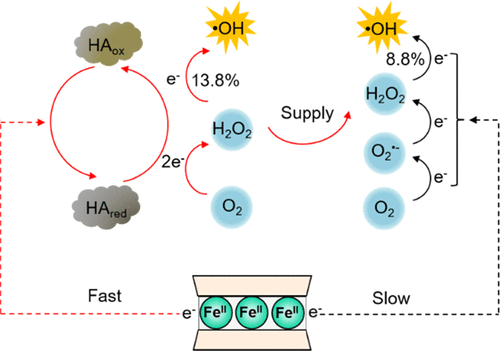当前位置:
X-MOL 学术
›
Environ. Sci. Technol.
›
论文详情
Our official English website, www.x-mol.net, welcomes your
feedback! (Note: you will need to create a separate account there.)
Mechanistic Insight into Humic Acid-Enhanced Hydroxyl Radical Production from Fe(II)-Bearing Clay Mineral Oxygenation
Environmental Science & Technology ( IF 10.8 ) Pub Date : 2021-09-22 , DOI: 10.1021/acs.est.1c02461 Chenglong Yu 1 , Yanting Zhang 1 , Yuxi Lu 1 , Ao Qian 1 , Peng Zhang 1 , Yanping Cui 2 , Songhu Yuan 1
Environmental Science & Technology ( IF 10.8 ) Pub Date : 2021-09-22 , DOI: 10.1021/acs.est.1c02461 Chenglong Yu 1 , Yanting Zhang 1 , Yuxi Lu 1 , Ao Qian 1 , Peng Zhang 1 , Yanping Cui 2 , Songhu Yuan 1
Affiliation

|
Hydroxyl radical (•OH) production by electron transfer from Fe(II)-bearing clay minerals to oxygen has been increasingly reported. However, the influence of ubiquitous coexisting humic acid (HA) on this process is poorly understood. Here, we investigated the effect of different HA on •OH production during the oxygenation of reduced nontronite NAu-2 (rNAu-2), montmorillonite, and sediment. Results showed that HA could enhance •OH production, and the enhancement was related to the content of reactive Fe(II) in rNAu-2 and the electron-accepting capacity of HA. Coexisting HA leads to a new electron-transfer pathway from Fe(II) in rNAu-2 to HA (instead of the HA–Fe complex) and then to O2, changing the first step of O2 reduction from one- to two-electron transfer process with H2O2 as the main intermediate. Reduced HA decomposes H2O2 to •OH at a higher yield (13.8%) than rNAu-2 (8.8%). Modeling results reveal that the HA-mediated electron-transfer pathway contributes to 12.6–70.2% of H2O2 generation and 13.2–62.1% of •OH formation from H2O2 decomposition, with larger contributions at higher HA concentrations (5–100 mg C/L). Our findings implicate that HA-mediated electron transfer can expand the area of •OH production from the mineral surface to the aqueous phase and increase the yield of •OH production.
中文翻译:

从含 Fe(II) 的粘土矿物氧化中对腐植酸增强羟基自由基生产的机理洞察
越来越多的报道称,通过从含 Fe(II) 的粘土矿物到氧的电子转移产生羟基自由基 (•OH)。然而,普遍存在的共存腐殖酸 (HA) 对该过程的影响知之甚少。在这里,我们研究了不同 HA 对还原脱钙 Nau-2 (rNAu-2)、蒙脱石和沉积物氧化过程中 •OH 生成的影响。结果表明,HA可以促进•OH的产生,其增强作用与rNAu-2中反应性Fe(II)的含量和HA的电子接受能力有关。共存的 HA 导致新的电子转移途径从 rNAu-2 中的 Fe(II) 到 HA(而不是 HA-Fe 复合物),然后到 O 2,将 O 2还原的第一步从一到二带H的电子转移过程2 O 2为主要中间体。还原的 HA以比 rNAu-2 (8.8%) 更高的产率 (13.8%)将 H 2 O 2分解为 •OH。建模结果表明,HA 介导的电子转移途径有助于产生 12.6-70.2% 的 H 2 O 2和 13.2-62.1% 的来自 H 2 O 2分解的 •OH 形成,在较高的 HA 浓度下贡献更大(5- 100 毫克 C/L)。我们的研究结果表明,HA 介导的电子转移可以扩大从矿物表面到水相的 •OH 生产区域,并增加 •OH 生产的产量。
更新日期:2021-10-06
中文翻译:

从含 Fe(II) 的粘土矿物氧化中对腐植酸增强羟基自由基生产的机理洞察
越来越多的报道称,通过从含 Fe(II) 的粘土矿物到氧的电子转移产生羟基自由基 (•OH)。然而,普遍存在的共存腐殖酸 (HA) 对该过程的影响知之甚少。在这里,我们研究了不同 HA 对还原脱钙 Nau-2 (rNAu-2)、蒙脱石和沉积物氧化过程中 •OH 生成的影响。结果表明,HA可以促进•OH的产生,其增强作用与rNAu-2中反应性Fe(II)的含量和HA的电子接受能力有关。共存的 HA 导致新的电子转移途径从 rNAu-2 中的 Fe(II) 到 HA(而不是 HA-Fe 复合物),然后到 O 2,将 O 2还原的第一步从一到二带H的电子转移过程2 O 2为主要中间体。还原的 HA以比 rNAu-2 (8.8%) 更高的产率 (13.8%)将 H 2 O 2分解为 •OH。建模结果表明,HA 介导的电子转移途径有助于产生 12.6-70.2% 的 H 2 O 2和 13.2-62.1% 的来自 H 2 O 2分解的 •OH 形成,在较高的 HA 浓度下贡献更大(5- 100 毫克 C/L)。我们的研究结果表明,HA 介导的电子转移可以扩大从矿物表面到水相的 •OH 生产区域,并增加 •OH 生产的产量。





















































 京公网安备 11010802027423号
京公网安备 11010802027423号